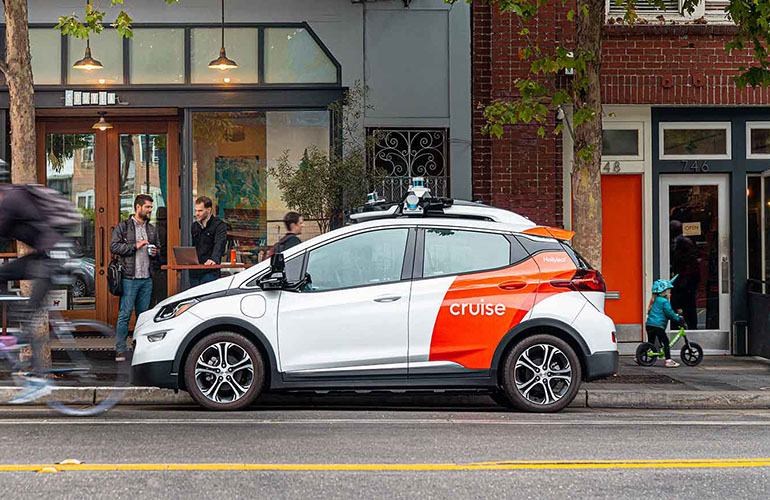|
Listen to this article  |

Despite launching its service in several cities in the U.S., Cruise faced challenges in recent months. | Source: Cruise
Cruise, the self-driving car unit of GM, continues to face troubles. Cruse president and CTO Mo ElShenawy sent an email to employees this morning informing them that the company is laying off 24% of its workforce, or 900 employees. Before the cuts, Cruise had 3,800 employees.
The email said the layoffs would primarily affect commercial operations and related corporate functions. While the impacts of the layoffs are largely outside of Cruise’s engineering team, the company said some tech positions will also be impacted.
“We knew this day was coming, but that does not make it any less difficult—especially for those whose jobs are affected,” ElShenawy said in the email. “Today, we are making staff reductions that will affect 24% of full-time Cruisers, through no fault of their own.”
Those affected by the layoffs will receive paychecks until Feb. 12, at least an additional eight weeks of pay, and severance based on tenure, according to the email.
These sweeping layoffs come on the heels of news that Cruise would be letting go of nine key people within the company amid an ongoing safety investigation. According to Reuters, those dismissed include chief legal and policy officer Jeff Bleich and senior vice president of government affairs David Estrada.
In November, Cruise also laid off contractor workers who were responsible for cleaning, charging, and maintaining vehicles.
Cruise’s highs and lows
Cruise had been focused on pushing its budding robotaxi service into more cities across the U.S. Just a few months ago, it was running services in San Francisco, Austin, Houston, and Phoenix, and had plans to expand to more than a dozen cities in 2024. According to co-founder and former chief product officer Dan Kan, Cruise was doing up to 10,000 autonomous rides per week.
These successes didn’t come without issues. Earlier this year, the company issued a voluntary recall of 300 Cruise vehicles with the National Highway Transportation Safety Administration (NHTSA). The recall was in response to a minor collision where a Cruise robotaxi hit the back of a San Francisco bus.
Cruise’s autonomous driving system is also currently being investigated by NHTSA. In a filing, NHSTA said it was interested in two different issues that had been reported to the administration that both resulted in the robotaxis becoming hazards for others on the road.
Despite these issues, the company continued to expand its operations. In August 2023, the California Public Utilities Commission (CPUC) voted to grant Cruise its final permits, alongside Waymo. This allowed the company to charge for all rides, expand hourly operations and service areas, and add as many robotaxis to the company’s fleet as it wanted.
 Submit your nominations for innovation awards in the 2024 RBR50 awards.
Submit your nominations for innovation awards in the 2024 RBR50 awards.
Cruise suspends nationwide operations
Despite its challenges, Cruise seemed to be going strong until an Oct. 2 incident that would be a catalyst for the company eventually pausing all of its operations nationwide. During the incident, a Cruise robotaxi dragged a woman after she was hit by a different car driven by a human. After being hit by the first car, the woman was thrown into the path of the Cruise vehicle, which couldn’t brake in time to avoid her.
On October 24, California’s Department of Motor Vehicles (DMV) immediately suspended Cruise’s autonomous vehicle deployment and driverless testing permits. The DMV said it suspended the permits because Cruise vehicles pose a risk to the public based on a string of recent incidents and because the company “misrepresented” the safety of its robotaxis.
California officials said Cruise withheld footage of the October 2 incident that shows Cruise’s robotaxi attempting to pull over while the pedestrian was under the vehicle. This maneuver dragged the woman for around 20 feet at a speed of 7 MPH before stopping. Cruise disputes that it withheld footage or information from the DMV, but it paused all of its operations nationwide to reestablish trust with the public.
In late November, Cruise’s co-founder and CEO Kyle Vogt and Kan resigned. Elshenawy, Cruise’s former executive vice president of engineering, took over as president and CTO.
What’s next for Cruise?
In its email to employees sent this morning, Cruise said that it would be focusing on developing a fully driverless L4 robotaxi service. The company plans to re-launch its ride-hailing services in one city to start.
Cruise also said that it would be haunting operations on its purpose-built Origin vehicle. In October, Cruise announced that it would work with GM and Honda to roll these vehicles out in Japan in early 2026. It’s unclear if the company is still planning for this deployment.
In October, GM said it had lost roughly $1.9 billion on Cruise in the first nine months of 2023, including $732 million in just the third quarter. Since 2017, the company has lost more than $8 billion. GM originally believed that Cruise could generate $50 billion in revenue for the company by 2030, and it hasn’t backed down from that estimate in recent months.
GM announced in November that it plans to cut spending on Cruise by “hundreds of millions of dollars in 2024.” Cruise’s internal investigation of the Oct. 2 incident is expected to last until January 2024.
“As we look forward, the road to successful commercialization is dependent on defining and meeting an exceptional performance and heightened safety bar. Cruise is committed to playing a key role in defining these standards with the input of our regulators, our communities and other AV industry leaders,” the company said in a statement.
Editor’s Note: The Robot Report reached out to Cruise for comment on the layoffs, but had not heard back at press time.
Credit: Source link


Comments are closed.